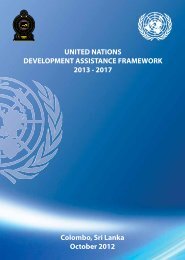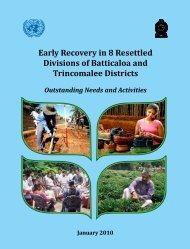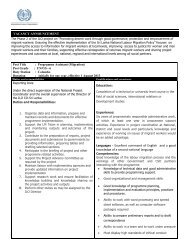Sri Lanka Human Development Report 2012.pdf
Sri Lanka Human Development Report 2012.pdf
Sri Lanka Human Development Report 2012.pdf
Create successful ePaper yourself
Turn your PDF publications into a flip-book with our unique Google optimized e-Paper software.
CHAPTER<br />
5<br />
Bridging<br />
<strong>Human</strong> <strong>Development</strong> Gaps: Employment and Livelihoods<br />
Access to productive employment is a key element of<br />
human development, as it is the means by which people<br />
reap the benefits of investments in health and education.<br />
When people do not have assets providing adequate<br />
incomes, productive employment remains a key channel<br />
out of poverty, although it may not be sufficient by itself.<br />
The type and nature of employment people can find is<br />
also important. Poor employment opportunities may lead<br />
mainly to social unrest.<br />
While <strong>Sri</strong> <strong>Lanka</strong>’s unemployment rate is relatively low,<br />
employment growth lags considerably behind GDP<br />
Labour Market Performance<br />
There were 8.1 million economically active people in<br />
<strong>Sri</strong> <strong>Lanka</strong> in 2010, 199 comprising roughly half the<br />
population above age 15, for a labour force participation<br />
rate of 53.4 percent. Men were twice as likely to participate<br />
in the labour market as women. 200 The rates for rural<br />
and urban populations were 54.4 and 46.8 percent,<br />
respectively.<br />
For the country as a whole, the unemployment rate was 4.9<br />
percent in 2010, an improvement over the 7.6 percent rate<br />
in 2000. 201 But high unemployment among more educated<br />
Figure 5.1: Unemployment Rate by Education Level, Age Group and Sex, 2010<br />
Note: Total excludes the Northern Province.<br />
Source: Department of Census and Statistics of <strong>Sri</strong> <strong>Lanka</strong> 2010a.<br />
growth, which averaged at least 5 percent from 1990 to<br />
2001. Further, the quality of jobs created has been poor.<br />
This chapter examines the performance of the labour<br />
market in <strong>Sri</strong> <strong>Lanka</strong>, recognizing that outside the Western<br />
Province, most people are dependent upon agriculture for<br />
employment. It then explores ways to improve agricultural<br />
productivity and access to other types of employment<br />
opportunities.<br />
people, youths and women (Figure 5.1), especially outside<br />
the Western Province, is a major concern. Various factors<br />
explain this phenomenon, including the relevance of skills<br />
taught by the education system, differences in the terms<br />
and conditions of employment across sectors, and slow job<br />
creation.<br />
The unemployment rate for people with an A-Level<br />
education and above was 11.6 percent in 2010, more than<br />
sri lanka <strong>Human</strong> <strong>Development</strong> report 2012 81






